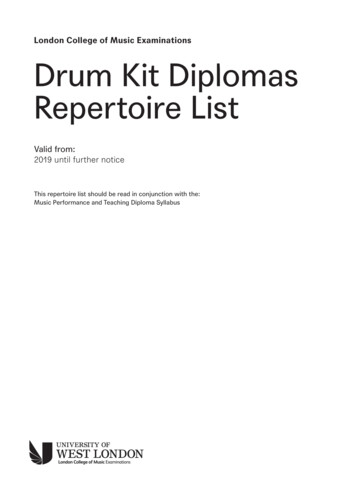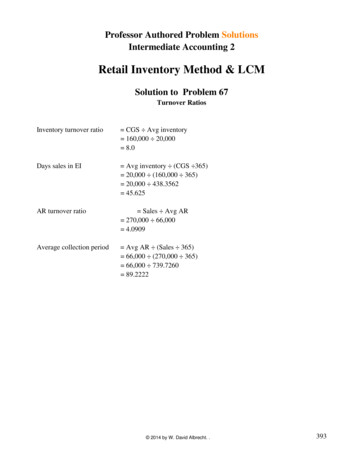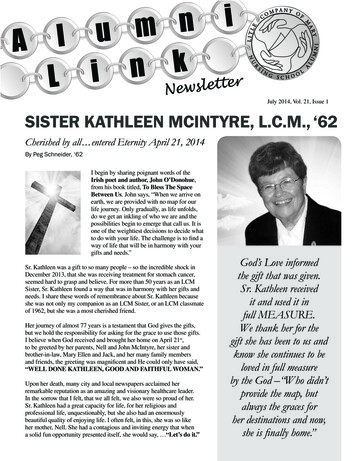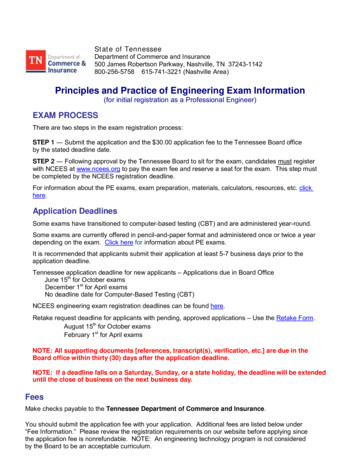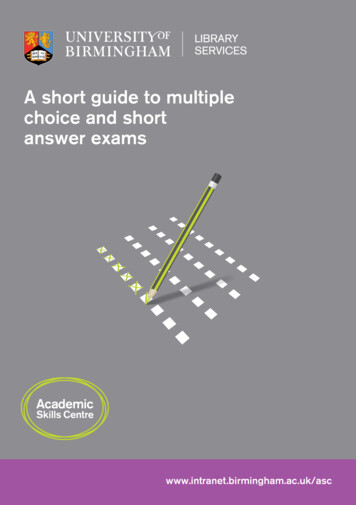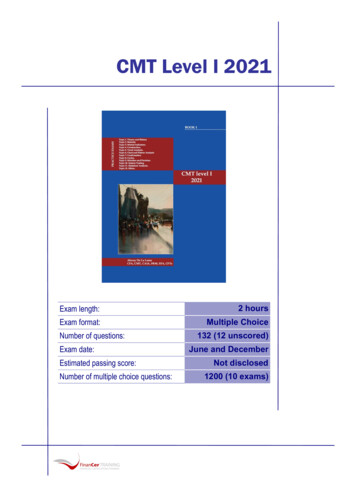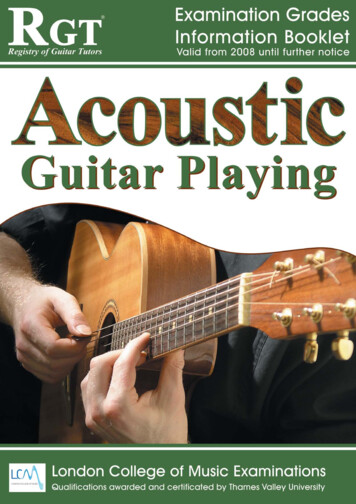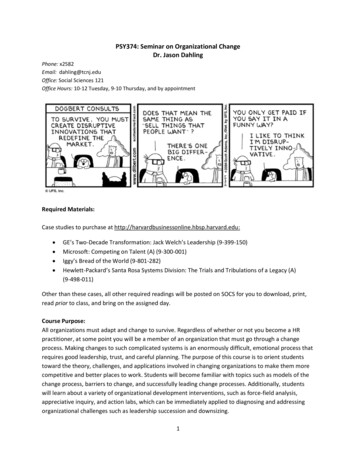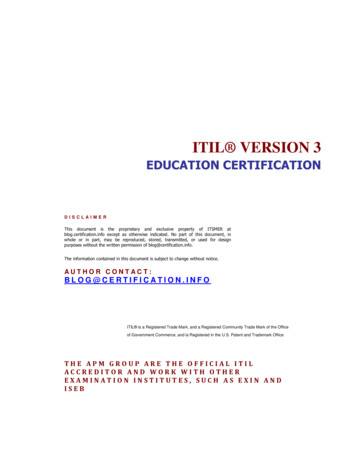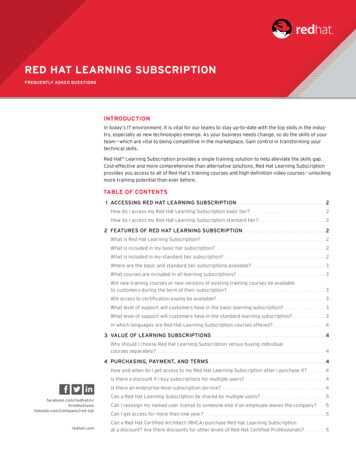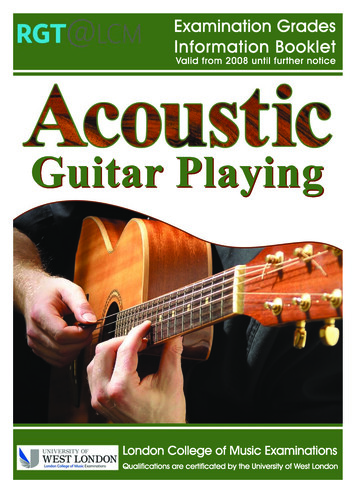
Transcription
RGT@LCMRegistry of Guitar Tutorsat London College of Music“RGT@LCM offers quality exams you can have confidence in.”About Registry of Guitar Tutors (RGT)RGT was established in the UK in1992 and is now the world’s premierorganisation of guitar educators. Tofind a registered guitar tutor in yourarea visit www.RGT.orgRGT exams are operated in partnershipwith London College of Music Exams,which was founded in 1887 and is oneof the world’s most respected musicexamination boards.RGT organises guitar exams,from beginner to professionalDiploma level, in numerouscountries around the world.RGT qualifications are awarded andcertificated by the University of WestLondon and, from Grade One onwards,are regulated by Ofqual.RGT offers exams in rock guitar,electric guitar, acoustic guitar,bass guitar, jazz guitar andpopular music theory.From Grade Six to Grade Eight, RGT examsattract UCAS points which can be usedtowards university entrance.To view more informationabout any RGT exams visitwww.RGT.orgFor more information about RGT visit www.RGT.orgRGT Board of Honorary Patrons:Sir Paul McCartney, David Gilmour, Hank Marvin, Ronnie Wood, John Etheridge, Gordon Giltrap,Suzi Quatro, Carlos Bonell, Dave Kelly, John Illsley, Neil Murray, Glenn Tilbrook.RGT@LCM, University of West London, St Mary’s Road, London W5 5RF020 8231 2751rgt.lcm@uwl.ac.ukwww.RGT.org Copyright 2007 by Registry of Guitar Tutors. Worldwide rights reserved.
Introduction To Acoustic Guitar ExaminationsInternationally Recognised QualificationsThese examinations offer a formal recognition of the specific talents of acoustic guitar players.The examinations have been developed by the Registry of Guitar Tutors (RGT), in association withLondon College of Music Examinations (one of the world’s most respected music examinationboards – established in 1887), and are awarded and certificated by the University of West London.These examinations, from Grade One to Eight, are regulated by Ofqual, and have been placedon the Qualifications and Credit Framework, so establishing a formal and recognised standard bywhich the skills and abilities of acoustic guitarists can be assessed. From Grade Six onwards, theexaminations attract UCAS points towards university entrance. The examinations are also endorsedby a range of eminent guitarists including Sir Paul McCartney and David Gilmour.A brief outline of what happens during an examinationThe examiner will begin by asking you to play a selection of chords and scales. The examinerwill then ask you to play through your chosen studies and/or pieces. At Grades One to Eight, theexaminer will ask you a few spoken questions to test your knowledge of the instrument and themusic performed; this is followed by a test to assess your accompaniment skills. From PreliminaryGrade onwards, the exam will conclude with the examiner testing your ‘ear for music’ by givingyou a selection of aural assessments.Marking structureThe following table shows the maximum marks that can be awarded in each section of theexamination.Initial Stage:Fingerboard Knowledge – 25Performance – 75Preliminary Grade:Fingerboard Knowledge – 15Performance – 75Aural Assessment – 10Grades 1 to 8:Fingerboard Knowledge – 10Performance – 50Musical Knowledge – 10Accompaniment – 20Aural Assessment – 1085 or above Distinction. 75-84.5 Merit. 65-74.5 Pass.55-64.5 Below Pass Upper Level. 0-54.5 Below Pass Lower Level.The requirements for each grade are shown on the following pages.
Examination ContentFingerboard KnowledgeThe examiner will request a selection of chords, scales and (from grade five) arpeggios fromthe lists below. Each chord should be strummed slowly, just once. Except at Initial Stage, scales and arpeggios should be played ascending anddescending, without repeating the top note. All presentations should be played from memory. Whilst it is stated below that some scales/chords may be required in 'any' key, candidateswill not be asked to play at pitches where fingerboard positions are inaccessible fortheir particular instrument.Initial Stage [Max 25 marks]Open position chords: C, G, Am, Em1 octave open position scales: C major and G major – ascending onlyPreliminary Grade [Max 15 marks]Open position chords: G, C, D, Am, Dm, Em1 octave open position scales: C major and G major – ascending and descendingGrade 1[Max 10 marks]As previous grade, plus:Open position chords: A, E, A7, B7, D7, E71 octave open position scales: D major, A natural minorGrade 2[Max 10 marks]As previous grades, plus:Open/first position chords: F, C7, G7, Amaj7, Cmaj7, Dmaj7, Fmaj7, Gmaj7, Am7, Dm7, Em72 octave open position scales: A major, A DorianGrade 3[Max 10 marks]As previous grades, plus:Open/first position chords: Asus2, Dsus2, Fsus2, Asus4, Csus4, Dsus4, Esus4, Fsus4, Gsus42 octave open position scales: G major, A natural minor, A MixolydianGrade 4[Max 10 marks]As previous grades, plus:Open/first position chords: A6, D6, E6, G6, Aadd9, Cadd9, Eadd9, Fadd9, Gadd92 octave open position scales: E major, E natural minor, E blues2 octave fretted major scales (played without the use of open strings): G, A, C, DGrade 5[Max 10 marks]Barre chords with ANY root note: major, minor2 octave fretted scales in ANY key: major, natural minor, blues2 octave open position arpeggios: A, G and E major; A and E minorGrade 6[Max 10 marks]Barre/fretted chords with ANY root note: major 7, minor 7, dominant 71 octave fretted major scales in 3 fingerboard positions in ANY key2 octave fretted scales in ANY key: pentatonic major, pentatonic minor2 octave major arpeggios with ANY root
Grade 7[Max 10 marks]Major chords with ANY root note in 3 different fingerboard positionsDiminished 7 chords with ANY rootMajor chords in 1st and 2nd inversion: C, D, E, G, A2 octave scales in ANY key: Mixolydian modal scale, Dorian modal scale, harmonic minor1 octave fretted scales in 3 fingerboard positions in ANY key: natural minor2 octave arpeggios with ANY root: minorGrade 8[Max 10 marks]Major chords with ANY root note in 4 different fingerboard positionsMinor chords with ANY root note in 3 different fingerboard positionsMinor chords in 1st and 2nd inversion: Am, Dm, Em1 octave scales in 5 fingerboard positions in ANY key: major1 octave C major scale harmonised in 3rds and 6ths1 octave G major scale harmonised in 10ths2 octave arpeggios with ANY root: dominant 7Each examination grade handbook provides all the chords, scales and arpeggios requiredfor the grade in notation, tablature and fretbox formats.PerformancePerformances do NOT need to be from memory.Initial Stage and Preliminary GradeA)The candidate should select and play ONE Rhythm Playing Study, chosen from the three Rhythm PlayingStudies contained in the examination handbook. [Max. 25 marks]B)The candidate should select and play TWO melodies. At least ONE must be chosen from the fourtraditional melodies contained in the examination handbook (see Appendix 1 for list of melodies). Ifpreferred, one melody can be a 'free choice' by the candidate of any other well-known melody from 1960onwards – providing it is of at least similar technical standard and duration to the melodies within theexamination handbook. (Candidates should bring copies of the notation of any free choice melodies tothe examination for the examiner to view.) Melodies can be played with a pick or using fingers, aspreferred by the candidate. [Max. 50 marks]Grades 1 and 2Candidates should perform a total of TWO pieces: ONE Rhythm Playing Study (from Group A),plus either ONE Fingerstyle Study (from Group B1) or ONE Melody (from Group B2). All areincluded in the examination handbook.A)The candidate should select and play ONE Rhythm Playing study, chosen from the three Rhythm Playingstudies contained in the examination handbook. [Max. 25 marks]B1) The candidate should select and play ONE Fingerstyle study, chosen from the two Fingerstyle studiescontained in the examination handbook. [Max. 25 marks]ORB2) The candidate should select and play ONE melody, chosen either from the four traditional melodiescontained in the examination handbook (see Appendix 1 for list of melodies) OR any well-known melodychosen by the candidate from 1960 onwards providing it is of at least similar technical standard andduration to the melodies within the examination handbook. (Candidates should bring copies of thenotation of any free choice melody to the exam for the examiner to view.) The melody can be played witha pick or using fingers, as preferred by the candidate. [Max. 25 marks]
Grades 3, 4 and 5Performance section continued.Candidates should perform a total of TWO pieces: ONE Rhythm Playing Study from Group A,plus ONE piece from Group B.A)The candidate should select and play ONE Rhythm Playing study, chosen from the three Rhythm Playingstudies contained in the examination handbook. [Max. 25 marks]B)The candidate should select and play either ONE piece chosen from the four in the examinationhandbook (see Appendix 2 for list of pieces) or ONE piece of similar standard chosen from the list ofsuggested pieces (see Appendix 3) or ONE 'free choice' piece (self-composed or otherwise) providingit is of at least similar standard to the set pieces within the grade. (Candidates should bring copiesof any free choice pieces, in standard notation or tablature, to the examination for the examiner toview.) [Max. 25 marks]Grades 6, 7 and 8Candidates should perform a total of TWO pieces, demonstrating some variety in musicalstyle and a range of technical ability. At these grades candidates are allowed to interpretthe pieces in their own style, rather than sticking rigidly to the arrangement shown in thenotation, providing the technical level is not simplified.The two pieces can be selected from the following sources: At least ONE piece from the four pieces contained in the examination handbook (see Appendix 2 for listof pieces). [Max. 25 marks] A maximum of ONE piece from the list of suggested alternative pieces (see Appendix 3) or ONE 'Freechoice piece'. This can be any piece (self-composed or otherwise) providing it is of at least similarstandard to the set pieces within the grade. This could include pieces with altered tuning (e.g.dropped D, DADGAD, open G, etc.) or specialist styles of guitar playing such as slide guitar. (Asecond guitar can be brought to the examination for this purpose if preferred). Candidates shouldbring copies of any free choice pieces, in standard notation or tablature, to the examination for theexaminer to view. [Max. 25 marks]All performance pieces are included in the relevant grade examination handbook and onthe accompanying CD.Musical Knowledge (from Grade one onwards)[Max 10 marks]Candidates may be asked questions relating to any of the topics listed below. The range,depth and complexity of the questions increases as the grades progress.Grade 1 and 2Questions to test the candidate's knowledge about the basic anatomy of the guitar: notes on the fingerboard,parts of the guitar.Grade 3, 4 and 5Questions to test the candidate's knowledge of the solo pieces performed (e.g. key, time signature, understandingof dynamics and repeat marks, techniques used).Grade 6, 7 and 8Discussion and questions arising from, but not limited exclusively to, the music performed, covering not only thetopics listed in previous grades but also the selection of pieces, repertoire, widening musical and stylisticawareness and, where appropriate to the pieces performed, altered tunings, use of the capo and transposition.Candidates should consult the relevant grade examination handbook, which gives examplesand details of the requirements for this section of the examination.
Accompaniment (from Grade one onwards)[Max 20 marks]The examiner will play a short melody (either live on guitar or piano, or via cd) and thecandidate should provide an accompaniment. A wide range of musical styles may be used,reflecting those that normally involve acoustic guitar, such as traditional and contemporaryfolk, blues and ragtime, pop and light rock.The candidate will be shown a chord chart suitable for accompanying the melody. Themelody will first be played once for the candidate to listen to. It will then be played a furtherthree times without stopping. The candidate should perform a suitable accompanimentover the last two playings (the candidate's performance over the first of the three playings willnot be assessed and the first playing can be used either to 'practise' or just to read the chordchart). The style of the accompaniment is left to the candidate's discretion and the candidatecan chose to either strum or fingerpick.The range of the keys and chord symbols will reflect the chords required for the appropriategrade, and so the complexity of the chord progression will increase with the grades. Thenumber of chords that appear in the chord progression, the range of time signatures and therhythmic complexity of the melodies all increase as the grades progress.The demonstration of the candidate's level of musicality, expression, inventiveness and stylisticawareness is expected to grow as the grades progress.Grade 1 and 2The time signature will be limited to 44Grade 3, 4 and 5The range of time signatures will be limited to 34 and 44Grade 6, 7 and 8The range of time signatures will be 344 64 8Candidates should consult the relevant grade examination handbook, which gives full detailsand examples of the tests, including audio examples on the CD.Aural Assessment (from Preliminary Grade onwards)[Max 10 marks]Preliminary Grade to Grade 8Candidates' aural abilities will be assessed via five tests appropriate to the grade.Tests A, B, C) A 4 bar melody will be played. The tests involve keeping time by clapping the pulse of the melody,identifying the time signature of the melody and reproducing the rhythm of an extract from the melody. The rangeof time signatures, rhythmic complexity and length of extract will increase as the grades progress.Test D) Apart from at Preliminary Grade (where candidates identify the highest note of two notes), the test is toreproduce on guitar a short melodic phrase after the examiner plays it twice. The tests grow in rhythmic andmelodic range and complexity as the grades progress. The range of time signatures and keys increases with thegrade.Test E) This test involves recognising chords and movement between chords. The range of chords and cadentialmovements increases as the grades progress.Candidates should consult the relevant grade examination handbook, which gives full detailsand examples of the aural assessments, including audio examples on the accompanying CD.
Appendix 1List of melodies included in the grade handbooks for the Performance sectionInitial StageGrade 1When The Saints Go Marching In – C majorOn Top Of Old Smokey – C majorMichael Row The Boat Ashore – G majorKumbaya – G majorAuld Lang Syne – D majorThe Bear Dance – A minorMairi's Wedding – G majorSwing Low Sweet Chariot – G majorPreliminary GradeGrade 2Morning Has Broken – C majorAura Lea – C majorEarly One Morning – C majorFor He's A Jolly Good Fellow – G majorScarborough Fair – A DorianThe Skye Boat Song – A majorHouse Of The Rising Sun – A minorLondonderry Air – D majorAppendix 2List of solo pieces included in the grade handbooks for the Performance sectionGrade 3Grade 6Double Thumb Special – G majorRed Haired Boy – A MixolydianGet Sussed – D majorAthol Highlanders – A MixolydianAmazing Grace – A majorHometown Blues – E bluesOn The Road – E majorRake's of Kildare & The Blackthorn Stick – A DorianGrade 4Grade 7Freight Train – C majorDown By The Sally Gardens – D majorLet Love Add Up – A majorThe Rakes of Mallow – G majorSong for Eric – A majorAuburn – D majorInvocation – G minorOff To California and Harvest Home – G & D majorGrade 5Grade 8Mourning Air – E MixolydianEverglade – A majorCountry Mood – G majorThe Ten Penny Bit – A DorianI Dare You – D majorThe Coast Road – E majorAcoustic Fuel – D DorianThe Derry Hornpipe – D majorAppendix 3List of suggested alternative pieces for Performance sectionThis list is published on the RGT website (www.RegistryOfGuitarTutors.com), rather than in traditional print format,in order to enable it to be reviewed and updated regularly – with any books that go out of print being removedfrom the list and any suitable new publications being added to the list.Anyone without internet access can obtain a printed version of the current list upon request to the RGT office.Publishers are invited to forward any suitable publications to the RGT with a request for inclusion on this list.Inclusion will be at the discretion of the RGT Examinations Dept.There is no compulsion to select any of the pieces listed – candidates are allowed to select their own choice ofmaterial (self-composed or otherwise) providing it is of at least similar standard to the set pieces within the grade.The grade listed for each alternative piece is for general guidance only – to demonstrate the typical grade ofeach piece when performed reasonably well – but candidates should note that grade differentiation is primarilyby performance standard rather than purely by the piece chosen, therefore a piece may be suitable for a loweror higher grade depending upon the level of the actual performance. For example, at Grade Three a high levelof stylistic interpretation and expression is not expected, but if a piece listed at this grade was performed fluentlyand accurately with flair, character and style it could quite appropriately be entered for a higher grade.In order to make obtaining musical material easy for candidates, the list is deliberately biased towards piecesfor which good quality transcriptions/arrangements are readily available usually in both standard notation andtablature, often with the inclusion of a demonstration CD. You can view the list at www.RegistryOfGuitarTutors.com.
F REQUENTLYA SKED Q UESTIONSCan I Use An Electro-Acoustic Guitar For The Examination?Yes. You may play acoustic or electro-acoustic guitar. The use of solid-body electric guitars is permitted but NOTrecommended for these exams. If using a guitar that you wish to amplify you may need to supply your ownamplifier and you should be able to set-up this amplification and any effects units promptly and unaided. Theuse of nylon-strung 'classical' guitars is not recommended for the these exams from Grade Three onwards.Do I Have To Use The Fingering Given In The Examination Handbooks?No. The handbooks provide fingering for general guidance only. Alternative systematic and effective fingeringswill also be acceptable.Can I Enter Straight For Grade 8?Yes. Candidates may enter for any examination without having taken any preceding examination. In other words,you don't need to have taken Grade 1 to enter for Grade 2. However, it is recommended that you work through allthe handbooks to ensure that you develop your playing in a structured and comprehensive way.Can I Enter More Than One Examination At The Same Session?Yes. For example, you could take Grade 2 followed by Grade 3 on the same day.Do I Need To have Lessons With An RGT Tutor Before I Can Enter An Examination?No, you can enter whether you have a tutor or not - however tuition from a suitably experienced tutor wouldundoubtedly prove helpful in preparing for an examination.What Do I Get When I Pass?If you obtain the 65% pass mark you will be awarded an official Thames Valley University / London College ofMusic Examinations certificate for the relevant grade. This holds the same validity as those issued for classicalmusic examinations. If you achieve 75% you will be awarded a Merit certificate. If you obtain 85% you will beawarded a Distinction certificate.When Do Examinations Take Place?In the UK examinations are held 3 times a year. The entry deadlines are: 1st February for the March/April 'Spring'exams; 1st May for the June/July 'Summer' exams; 1st October for the November/December 'Winter' exams. Theexamination dates within these periods are dependent upon the availability of the venue and candidates ineach area and so the precise date cannot be determined until all candidates' entries are received andprocessed. Candidates will always be given a minimum of ten days advance notice of their examination date.Where Are Examinations Held?Examinations are held in a wide variety of venues. These may include rooms in schools, colleges, teachers'houses, rehearsal studios, guitar centres, arts centres and community halls.Will I Have To Travel Far?Not normally. There are examination centres spread widely across the UK. You will be assigned to the centreoperating nearest to your home address, usually within one hour travelling distance. Whether a centre is operatingin a particular session depends entirely upon the numbers of entrants from that area.Do I Have To Live In The UK?No. These examinations take place in many countries across the world. Special arrangements apply to non-UKexaminations. Candidates should view the RGT website for more information or contact the RGT head office (or thelocal representative) prior to submitting an examination entry.When The Exam Is Finished Will The Examiner Tell Me If I've Passed?No. After the examination the examiner will write a full examination report for you. The report will highlight yourstrengths and weaknesses, and list the marks awarded for each section. This will normally be sent to you withinfour weeks. If you have passed, the certificate will follow within eight weeks. If you have been entered for theexamination by your tutor, or if you have given the name of your tutor on your entry form, then all documentationwill be sent direct to your tutor.This syllabus was compiled on behalf of RGT by Tony Skinner with the advice and support of the RGT'sAcoustic Guitar Syllabus Consultative Panel:Stuart Ryan, Clive Carroll, Gordon Giltrap, John Renbourn, Terry Lees, Max Milligan, Al Summers,Laurence Harwood, Chaz Hart, David Millar, Colin Berrido, Lindsay Higgs, Graham Corbould, CarolDale, Ruth Harry, Edward Lee, Darren Eve, Jim Newman, Andrew Deevey, Tony Rath, Roger Coombs,Andrew McBirnie, Andrew Hatt, Alan Brown, Merv Young.
RGT offers exams in rock guitar, electric guitar, acoustic guitar, bass guitar, jazz guitar and popular music theory. To view more information about any RGT exams visit www.RGT.org RGT qualifications are awarded and certificated by the University of West Lon
